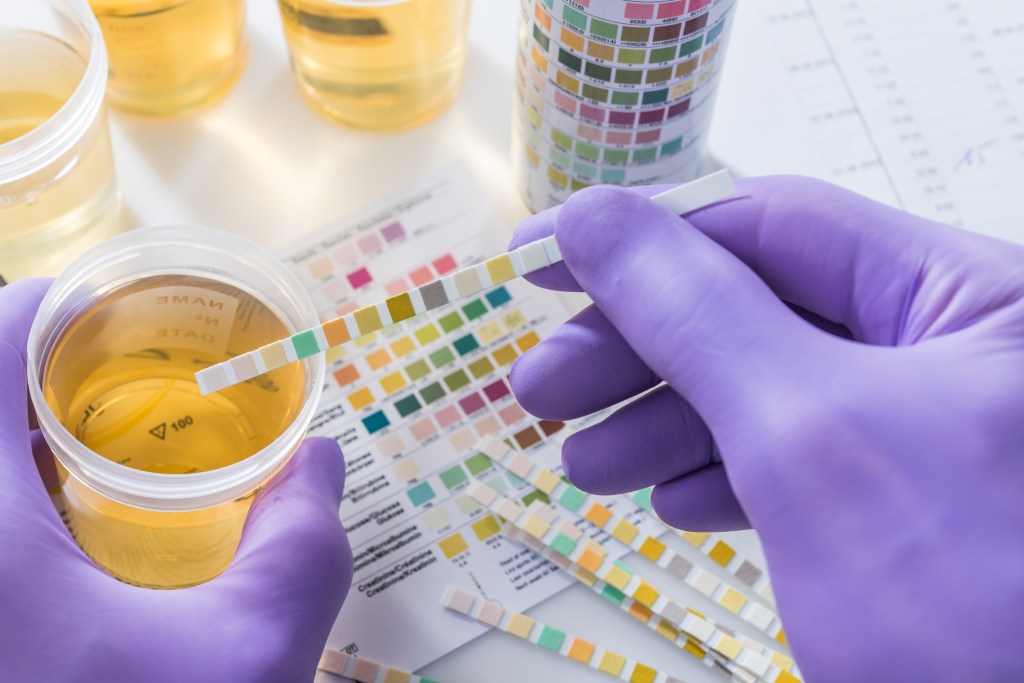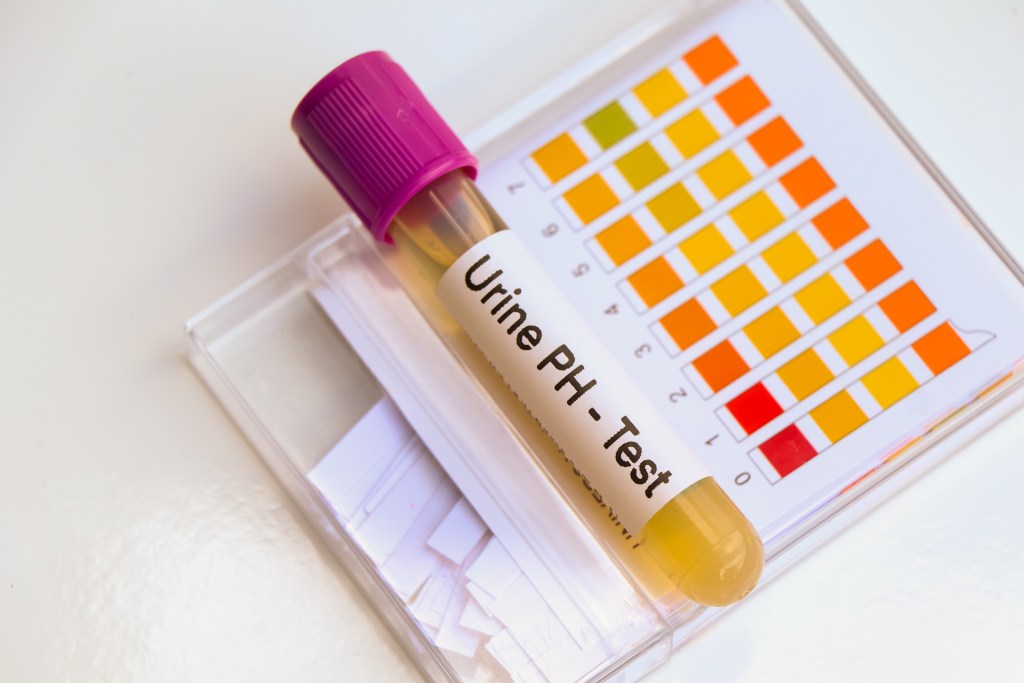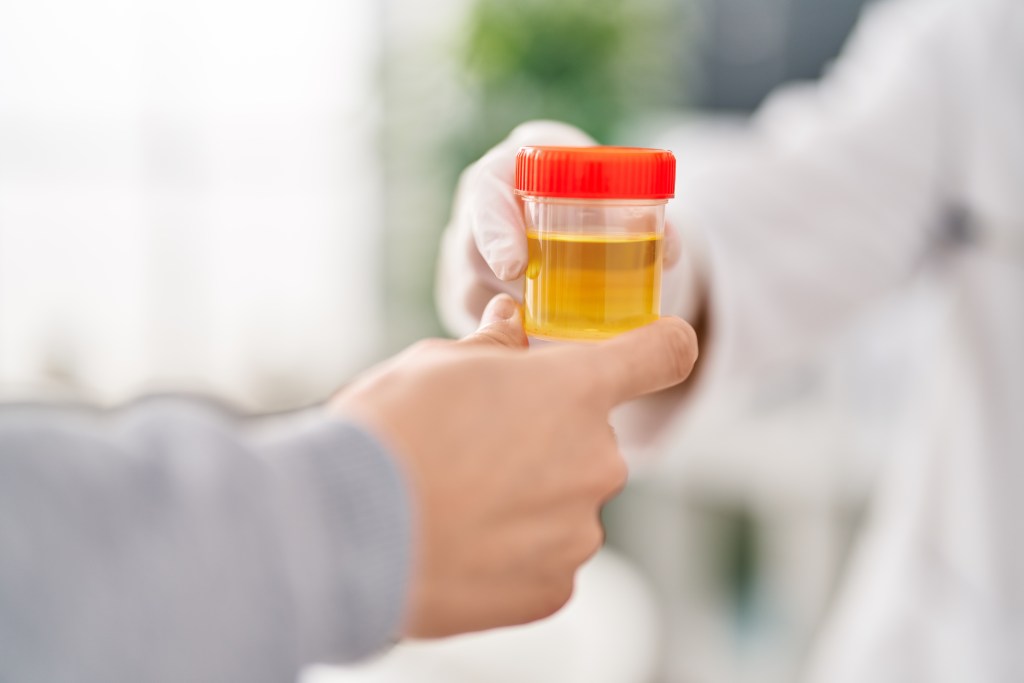Alkaline urine occurs when your pH level exceeds the normal urinary pH range of between 4.5 and 7.8.
Factors including your dietary habits, medication use, and underlying medical issues such as kidney stones or urinary tract infections can influence the pH balance in the urinary system and cause alkaline urine.
Let’s explore the symptoms and causes of high pH in urine and discover how pH urine test strips can help detect and prevent potential health issues.
What is pH?
The term pH refers to the potential of hydrogen, a measure of the concentration of hydrogen ions in a solution.
pH is generally expressed on a pH scale ranging from 0 to 14, with 0 being the most acidic and 14 being the most alkaline. A pH of 7 is neutral.
Different body fluids have different pH levels. For example, saliva has an average pH of 6.2 to 7.6, while a healthy blood pH ranges from 7.35 to 7.45.
Many biochemical processes require specific pH levels, and considerable changes to the body’s acid-base balance can lead to health issues such as uric acid stones and metabolic acidosis.
Factors such as sugar and stress can alter your acid-alkaline levels. While a diet high in sugars, carbs, and alcohol can make your urine acidic, the stress hormone cortisol can increase the body’s alkalinity and may lead to alkalosis.
Urinary pH levels are a marker of various physiological functions, and medical professionals regularly use pH tests to monitor and treat urinary tract infections (UTIs), metabolic disorders, kidney failure, renal tubular acidosis, and gastroesophageal reflux disease (GERD).
Watch this video to discover how your saliva and urine pH may help detect underlying health issues.
What is the normal pH range of urine?
According to research published by Pocket Companion to Brenner and Rector’s The Kidney, a urinary pH range between 4.5 and 7.8 is considered normal.1
A urine pH above 7.0 is considered alkaline and may contribute to the formation of certain types of kidney stones and increase the risk of UTIs.
On the other hand, a urine pH level below 5.0 indicates acidic urine, which may be linked to underlying health issues, such as diabetic ketoacidosis, kidney failure, and diarrhea.
Maintaining healthy pH levels is essential to support normal physiological functions and helps promote overall health and well-being.

What causes high pH in urine?
Alkaline urine can be caused by various factors such as dietary habits, medication use, and underlying health issues.
Early detection of changes in the body’s acid-base balance is crucial for the prompt diagnosis and appropriate management of potential underlying conditions, such as UTIs and kidney dysfunction.
Let’s take a look at three common causes of elevated pH levels.
1. High alkaline diet
Certain foods such as berries, vegetables, nuts, and legumes have an alkalizing effect on the body and may increase urinary pH levels.
Evidence published in Nutrition Journal suggests, “Alkalization of urine by eating nutritionally well-designed alkaline-prone food is effective for removing uric acid from the body.”2
Uric acid is a weak acid released during the breakdown of purines, which are natural compounds found in certain foods such as organ and game meats.
While maintaining a slightly alkaline environment can be beneficial, too much alkalinity can lead to various health issues, including low potassium and calcium levels, renal problems, and poor digestive functions.
It’s important to note that alkaline urine typically isn’t caused by consuming alkaline foods but can be linked to excessive intake of ionized alkaline water.
2. Medications
Certain medications used to manage kidney problems, hypertension, or heartburn can affect the body’s pH levels and lead to alkaline urine.
Potassium citrate is typically used in the prevention of kidney stones. When metabolized, potassium citrate is converted into bicarbonate, which is an alkaline compound that is filtered by the kidneys and excreted in the urine.
Diuretics are often prescribed to treat hypertension and edema, and research published by StatPearls found that prolonged use of diuretic drugs can increase the risk of hypokalemic metabolic alkalosis, a condition characterized by low potassium and elevated pH levels.3
Additionally, sodium bicarbonate, commonly known as baking soda, can help alleviate heartburn and acid reflux. However, bicarbonate metabolism can alter pH levels and increase the alkalinity of your urine.
Before taking a urine pH test, consult your doctor to determine whether it’s safe to stop or adjust your medication dosage.
3. Underlying medical conditions
Existing medical conditions such as microbial infection and gastrointestinal issues may increase urinary pH levels.
Certain bacterial species associated with UTIs produce urease, an enzyme that catalyzes the breakdown of urea into ammonia. Ammonia has alkaline properties and can raise the pH of body fluids, including urine.
A study published by Open Forum Infectious Diseases found that individuals who tested positive for alkaline urine were more likely to experience UTI and recurring infections.4
Furthermore, gastrointestinal issues, such as prolonged vomiting, can result in the loss of stomach acid, which can affect the body’s acid-base balance and increase the risk of alkaline urine.

Symptoms of high urine pH
Alkaline urine itself may not cause noticeable signs or symptoms, making it challenging to detect potential health issues early.
However, in some cases, underlying causes of high urinary pH can trigger specific symptoms indicative of an acid-base imbalance in the body.
Individuals with elevated urinary pH may experience the following symptoms:
- Confusion
- Nausea
- Vomiting
- Muscle spasms
- Numbness
- Heartburn
- Cold hands and feet
- Loss of taste and smell
If you are concerned about your pH levels or are experiencing symptoms indicative of acid-base imbalance, it’s crucial to consult a healthcare provider.

How to test urine pH
There are several simple ways to test your urine pH levels, such as using a urine dipstick or a litmus paper test.
An at-home urine test strip kit is a convenient option that involves a color-sensitive dipstick that helps establish the pH level of your urine.
The color of the dipstick will change depending on the pH value, and a color chart helps evaluate if your urine has an acidic or alkaline pH.
Similar to the dipstick test, a litmus paper test is a reliable method of evaluating your urinary pH levels.
Litmus paper works by changing color in response to the acidity or alkalinity of urine, providing a quick visual indicator of pH levels based on the color shift observed.

How to lower urine pH
To lower your urine pH levels, it’s crucial to maintain a nutritious diet and address underlying health issues.
Research published by the British Journal of Nutrition discovered that “vegetable intake and lower consumption of meat was significantly associated with a more alkaline urine pH.” 5
Additionally, a study published by Nefrología established that foods rich in high-quality protein, such as meat and dairy, have been found to increase the body’s acid production, which can counteract alkalinity and help restore pH level balance.6
Avoiding an alkaline diet and focusing on a nutritious diet rich in healthy fats, moderate protein, and a wide variety of nuts, berries, and vegetables can promote a healthy acid-base balance and lower urinary pH levels.
Treating underlying medical issues such as UTIs, diabetic ketoacidosis, or renal tubular acidosis is crucial to manage alkaline urine and maintain a normal acid-base balance in the body.

Key takeaways
A normal urinary pH level ranges from 4.5 to 7.8. pH levels above 7.0 indicate an alkaline urine, while a low urine pH below 5.0 is considered acidic.
Several factors, such as a diet high in alkaline-rich foods, certain medications, and underlying medical conditions, can disrupt the body’s acid-base balance and affect urine pH.
High pH in urine can increase the risk of UTIs and kidney stones and may indicate metabolic alkalosis, a condition characterized by elevated blood pH.
FAQ
1. What can cause higher urine pH?
Certain medications and underlying health conditions, such as kidney stones, can raise pH levels and lead to alkaline urine.
In addition, excessive intake of alkaline water can lead to changes in the body’s acid-base balance and increase the risk of elevated urine pH.
2. What does a pH of 8.5 in urine mean?
A urinary pH of 8.5 is considered alkaline and can be indicative of underlying health issues, including renal problems and gastrointestinal issues, or may be linked to certain medications or excessive intake of alkaline water.
3. How do you treat high pH in urine (alkaline urine)?
Treatment for elevated urinary pH levels involves avoiding an alkaline diet and consuming plenty of healthy fats, meat, fish, and dairy.
Elevated urinary pH levels can also indicate underlying health issues, and it’s crucial to consult your healthcare provider for a thorough evaluation of your health status.
4. Can a UTI cause high urine pH?
Yes, a urinary tract infection (UTI) can cause elevated urine pH levels.
Certain infectious bacteria linked to UTIs release ammonia, which raises pH levels and contributes to alkaline urine.
5. What is a normal urine pH level?
A normal urine pH level ranges from pH 4.5 to 7.8. Levels above 7.0 are considered alkaline, while levels below 5.0 indicate acidic urine.
6. What are the symptoms of high urinary pH?
Common signs and symptoms of elevated urine pH may include vomiting, recurring UTIs, nausea, confusion, numbness in the face and hands, and muscle spasms.
7. How do I test my urine pH?
Dipstick and litmus paper tests are widely available and a convenient way to test urinary pH levels at home. Both tests visualize the pH levels of urine based on color changes, which indicates either acidic or alkaline urine.
Sources
- https://www.sciencedirect.com/topics/immunology-and-microbiology/urine-ph ?
- https://www.ncbi.nlm.nih.gov/pmc/articles/PMC3406944/ ?
- https://www.ncbi.nlm.nih.gov/books/NBK532918/ ?
- https://www.ncbi.nlm.nih.gov/pmc/articles/PMC6809364/ ?
- https://pubmed.ncbi.nlm.nih.gov/18042305/ ?
- https://www.sciencedirect.com/science/article/pii/S2013251419301129 ?








